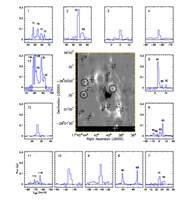Star Formation at the Galactic Center
 The authors present radio and infrared observations indicating ongoing star formation activity inside the ~2–5 pc circum-nuclear ring at the Galactic Center. Collectively these measurements suggest a continued disk-based mode of ongoing star formation has taken place near Sgr A* over the last few million years. VLA observations with 2.17 x 0.81 arcsec spatial resolution reveal 13 water masers, several of which have multiple velocity components. The presence of interstellar water masers suggests gas densities that are sufficient for self-gravity to overcome the tidal shear of the 4 x 106 M⊙ black hole., Spectral energy distribution modeling of stellar sources indicates massive young stellar object (YSO) candidates interior to the molecular ring, supporting in situ star formation near Sgr A* and appears to show a distribution similar to that of the counter-rotating disks of ~100 OB stars orbiting Sgr A*. Some YSO candidates have bow shock structures, suggesting that they have gaseous disks that are photo-evaporated and photo-ionized by the strong radiation field. The authors detect clumps of SiO (2-1) and (5-4) line emission in the ring based on CARMA observations. The FWHM and luminosity of the SiO emission is consistent with shocked protostellar outflows. Two linear ionized features with an extent of ~0.8 pc show blue and redshifted velocities between +50 and −40 km s−1, suggesting protostellar jet driven outflows with mass-loss rates of 5 x 10-5 M⊙. The authors also present the imprint of radio dark clouds at 44 GHz, representing a reservoir of molecular gas that feeds star formation activity close to Sgr A*.
The authors present radio and infrared observations indicating ongoing star formation activity inside the ~2–5 pc circum-nuclear ring at the Galactic Center. Collectively these measurements suggest a continued disk-based mode of ongoing star formation has taken place near Sgr A* over the last few million years. VLA observations with 2.17 x 0.81 arcsec spatial resolution reveal 13 water masers, several of which have multiple velocity components. The presence of interstellar water masers suggests gas densities that are sufficient for self-gravity to overcome the tidal shear of the 4 x 106 M⊙ black hole., Spectral energy distribution modeling of stellar sources indicates massive young stellar object (YSO) candidates interior to the molecular ring, supporting in situ star formation near Sgr A* and appears to show a distribution similar to that of the counter-rotating disks of ~100 OB stars orbiting Sgr A*. Some YSO candidates have bow shock structures, suggesting that they have gaseous disks that are photo-evaporated and photo-ionized by the strong radiation field. The authors detect clumps of SiO (2-1) and (5-4) line emission in the ring based on CARMA observations. The FWHM and luminosity of the SiO emission is consistent with shocked protostellar outflows. Two linear ionized features with an extent of ~0.8 pc show blue and redshifted velocities between +50 and −40 km s−1, suggesting protostellar jet driven outflows with mass-loss rates of 5 x 10-5 M⊙. The authors also present the imprint of radio dark clouds at 44 GHz, representing a reservoir of molecular gas that feeds star formation activity close to Sgr A*.
View Paper: Signatures of Young Star Formation Activity Within Two Parsecs of Sgr A*, F. Yusef-Zadeh (Northwestern), M. Wardle (Macquarie), M. Sewilo (SSI), D.A. Roberts (Northwestern), I. Smith (Macquarie), R. Arendt (NASA-GSFC), W. Cotton (NRAO), J. Lacy (Texas), S. Martin (IRAM), M.W. Pound (Maryland), M. Rickert (Northwestern), and M> royster (Northwestern), 2015 ApJ, 808, 97 (20 July 2015).




Connect with NRAO